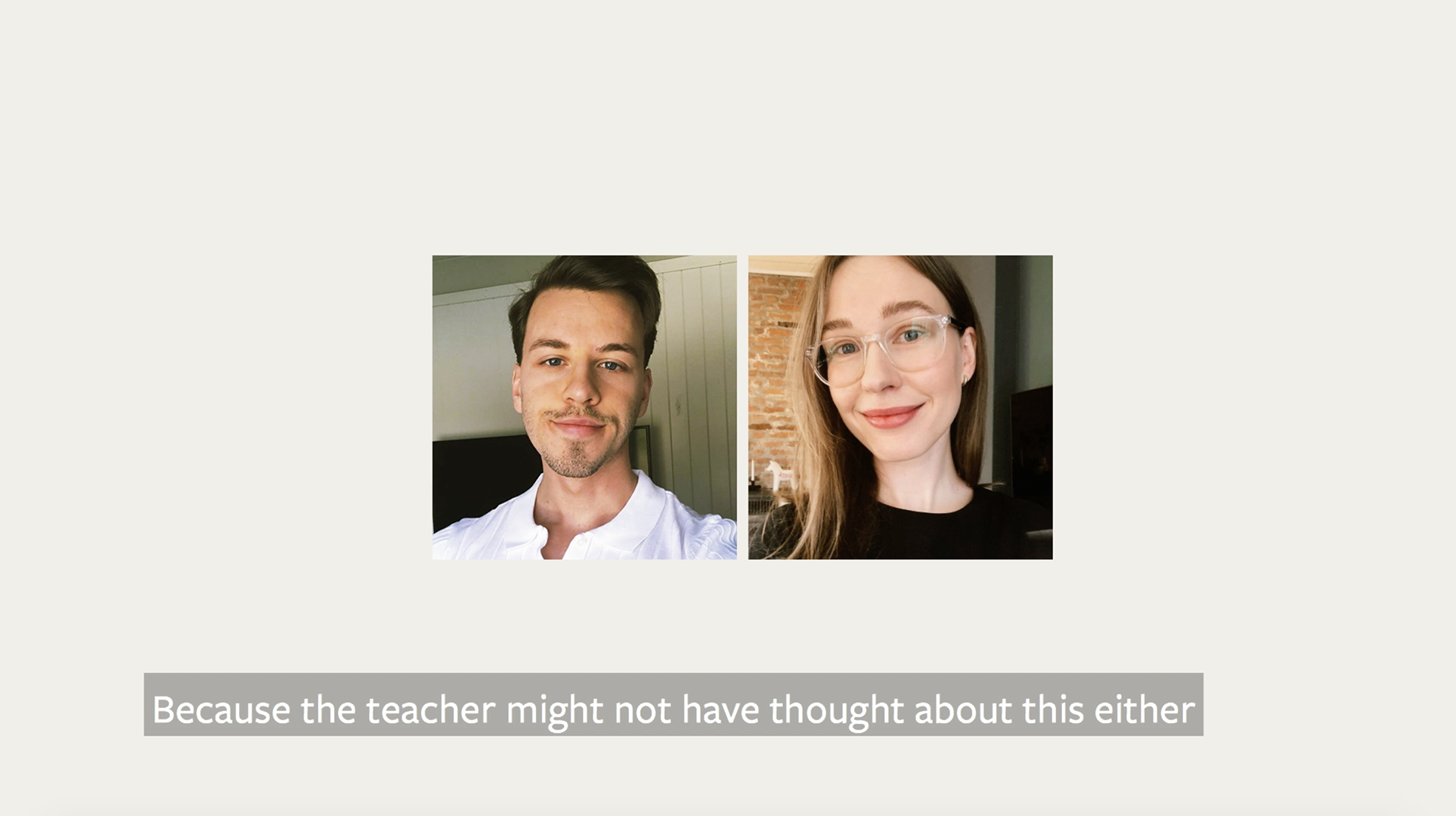Lecture notes
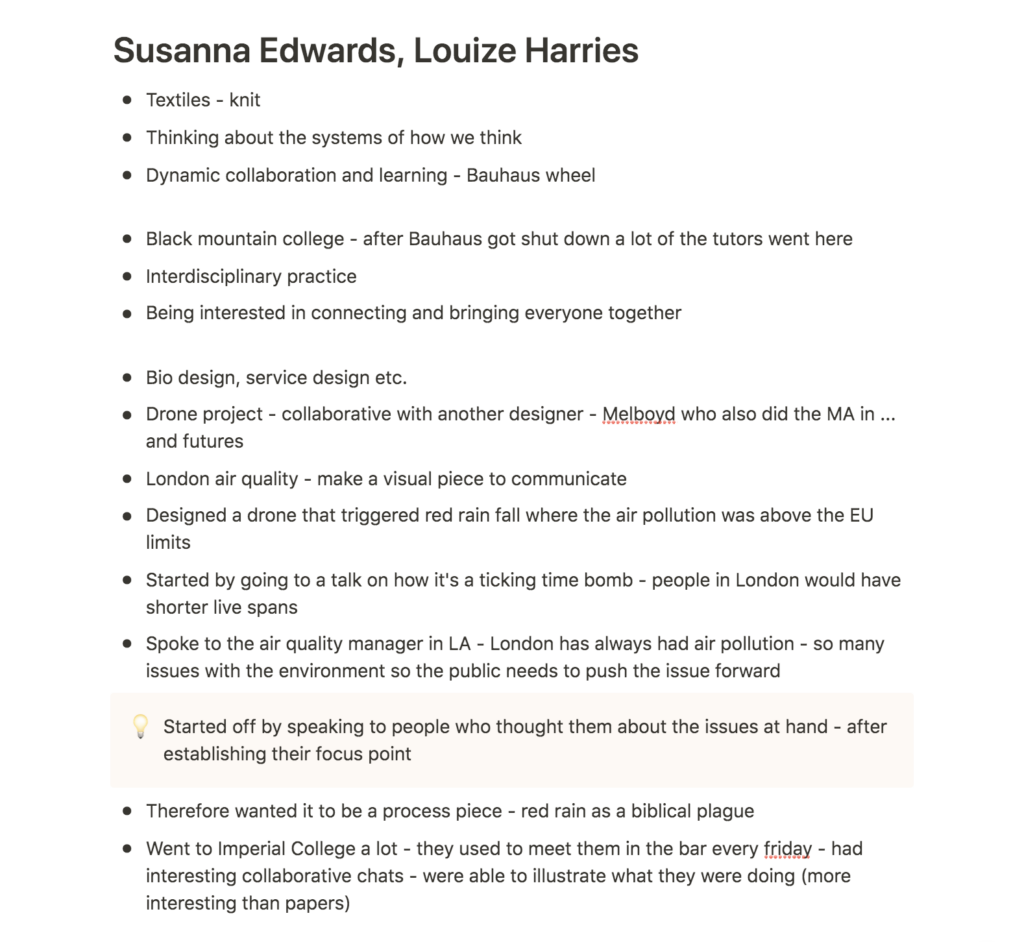
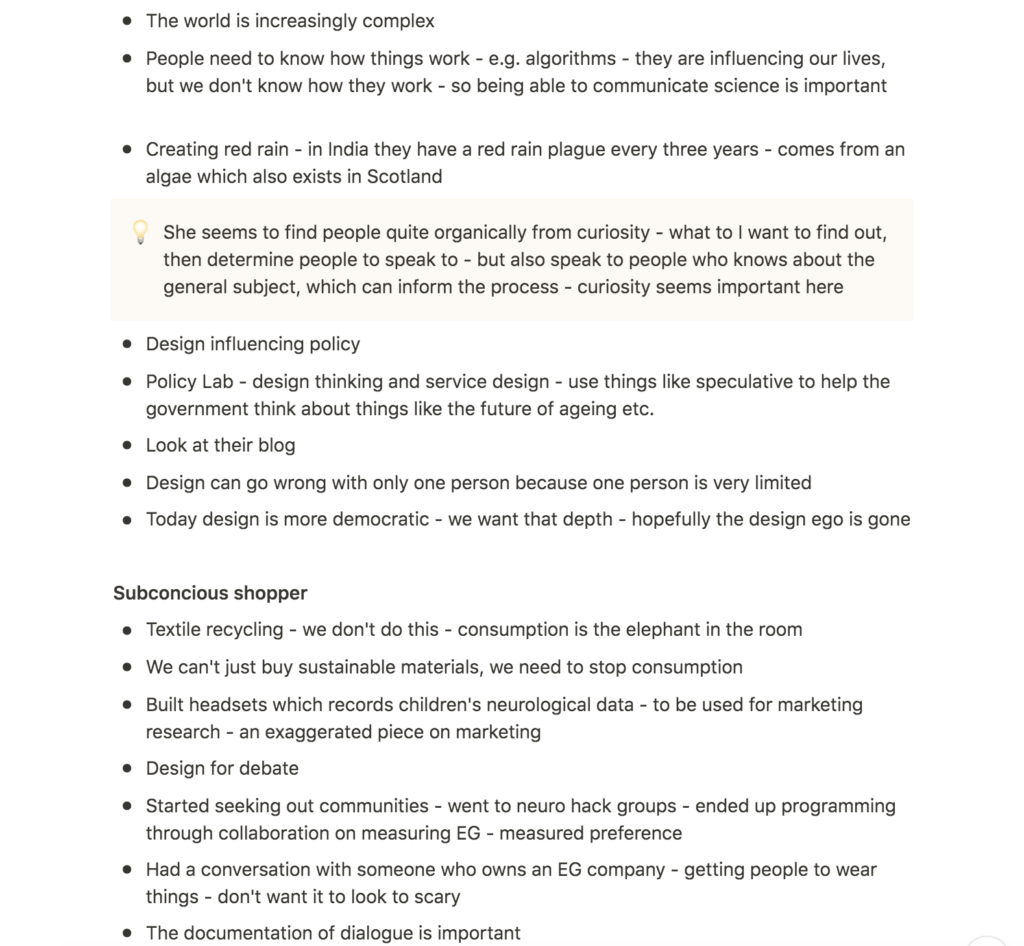
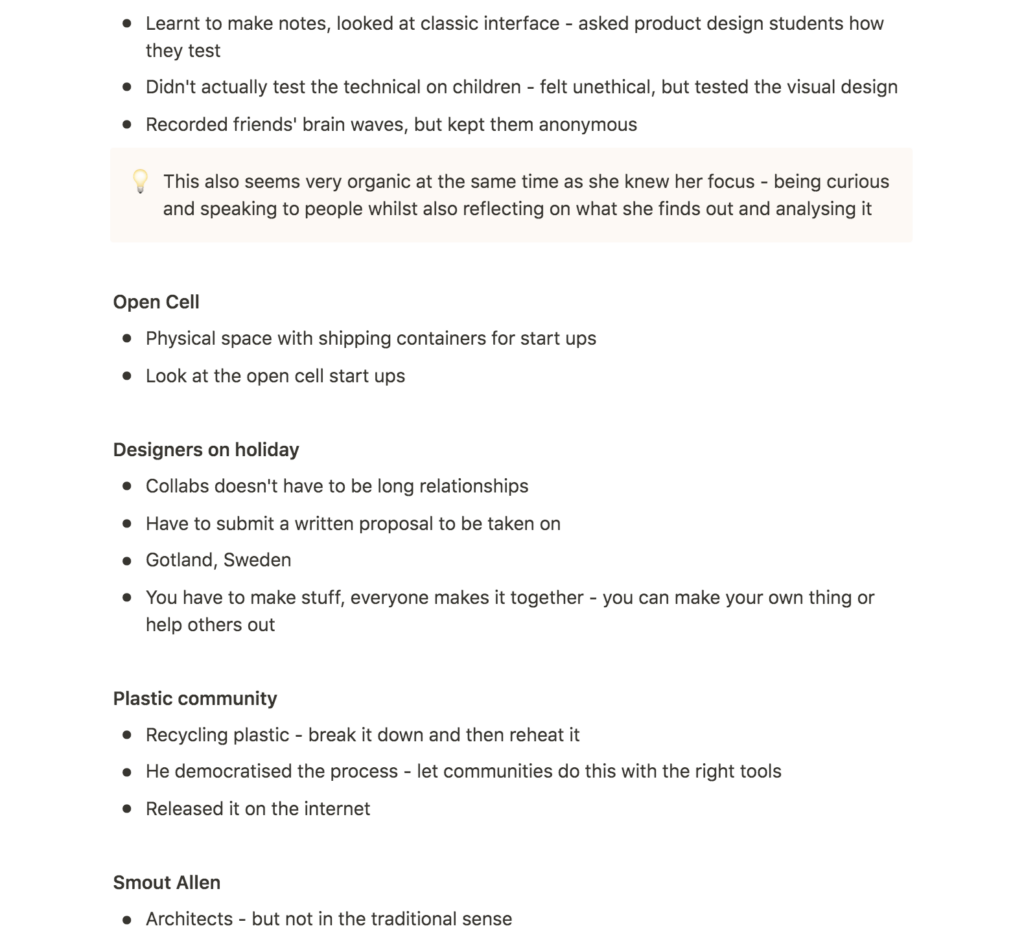
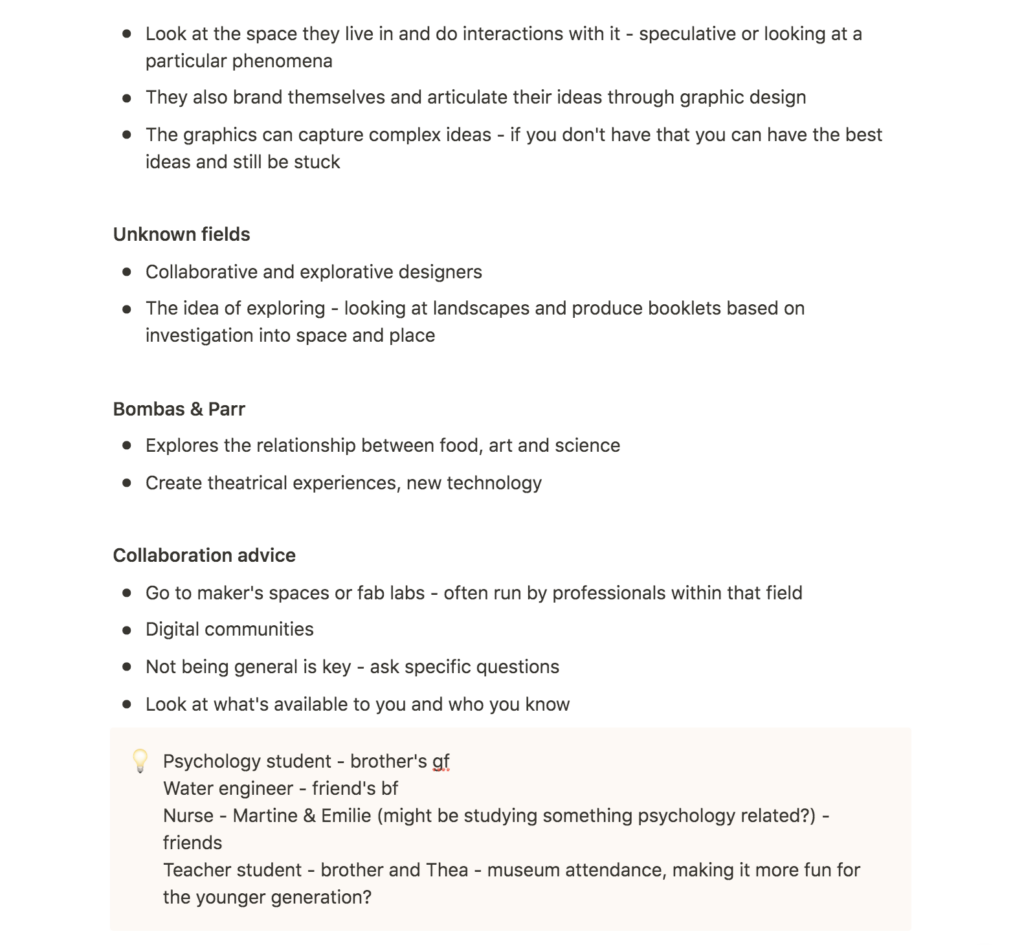
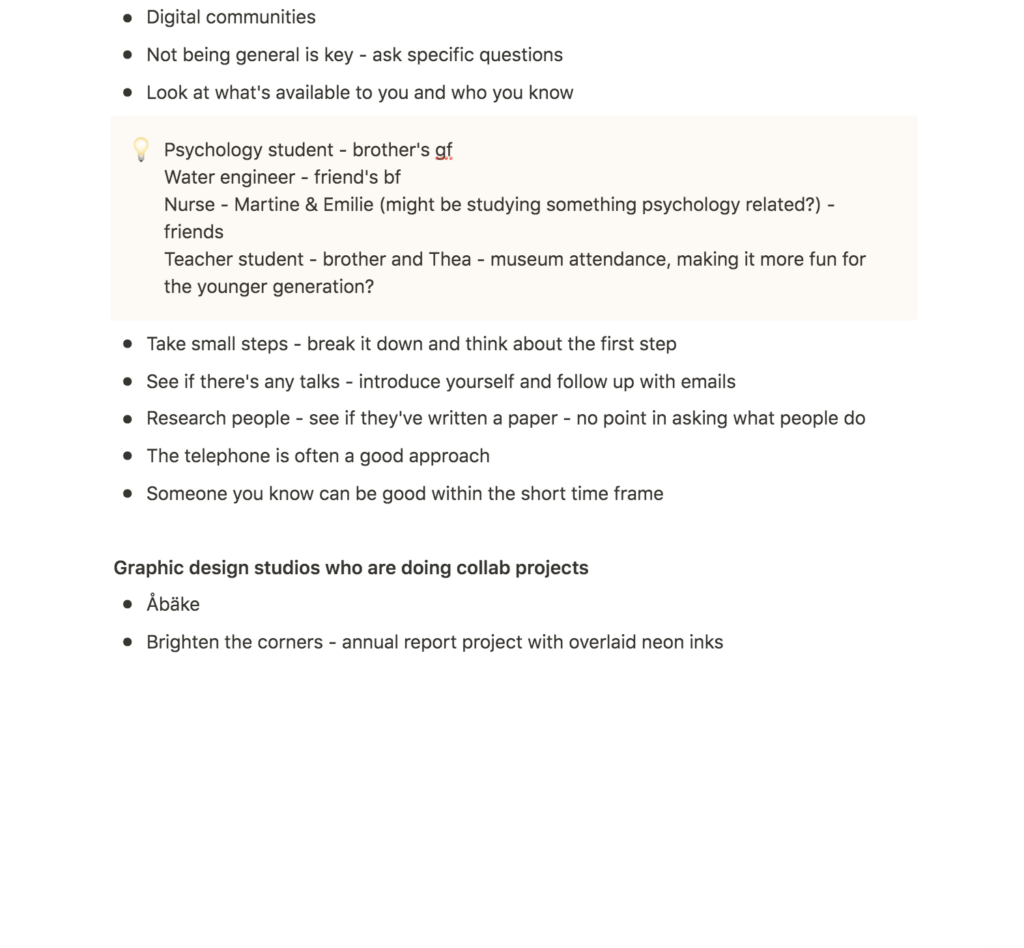
Lecture reflections
This week’s lecture podcast with Louize Harries was very insightful in terms of the organic way one might collaborate with experts throughout a project. Harries seemed to have a way of working where she first identified a focus, and then went on to find people to talk to in her research (Susanna Edwards and Louize Harries, 2021). The retained information was then used to inform her project, which then again informed who she talked to next (Susanna Edwards and Louize Harries, 2021). Thus, her way of using collaborators was quite similar to how I’ve personally done research in the past, only that I’ve done it with books and resources rather than people.
I was particularly fascinated by Harries’ curiosity, which seemed to be what drove her projects forward (Susanna Edwards and Louize Harries, 2021). Therefore, it seems important to work with something you’re truly curious about, in order to reveal such detailed information. There also seemed to be a continuous process of seeking out information, analysing it, implementing it and then seeking out new information, which almost let Harries’ projects go on forever, resulting in really detailed researched final results.
Resource notes
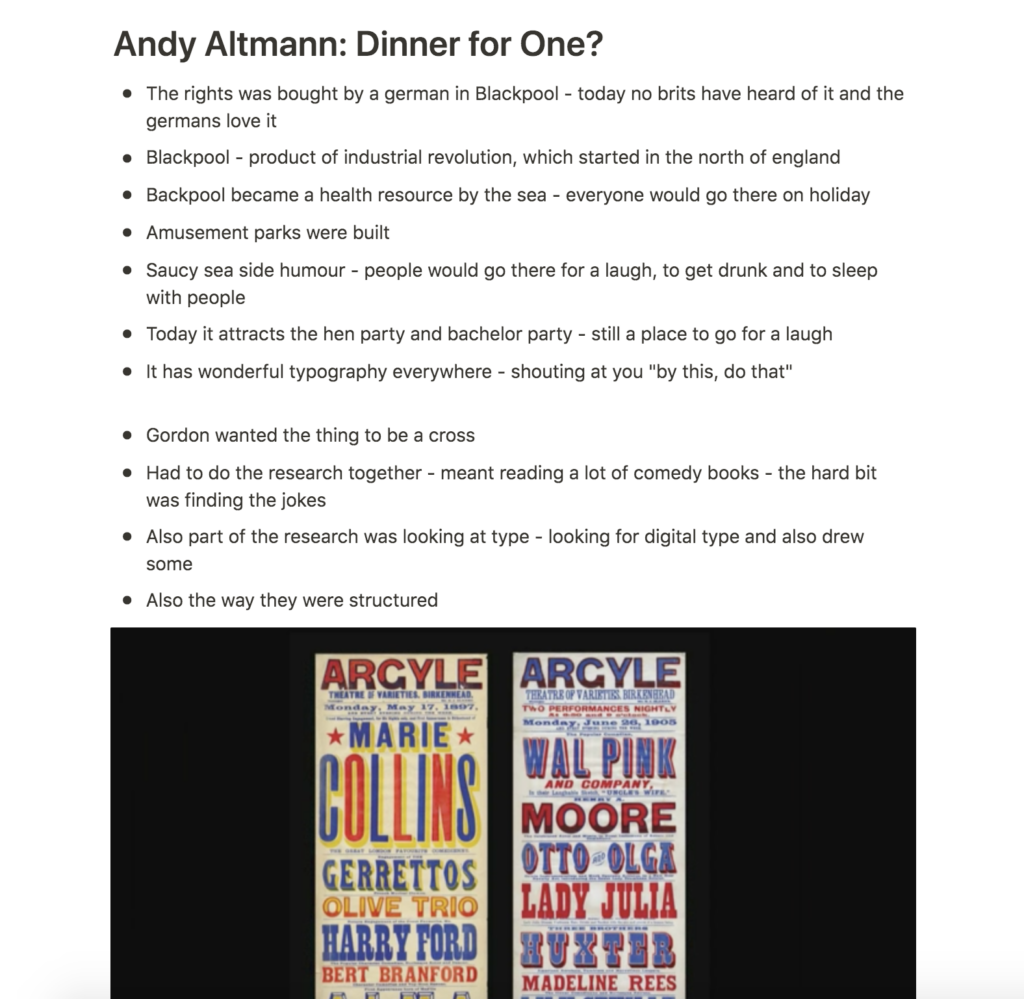
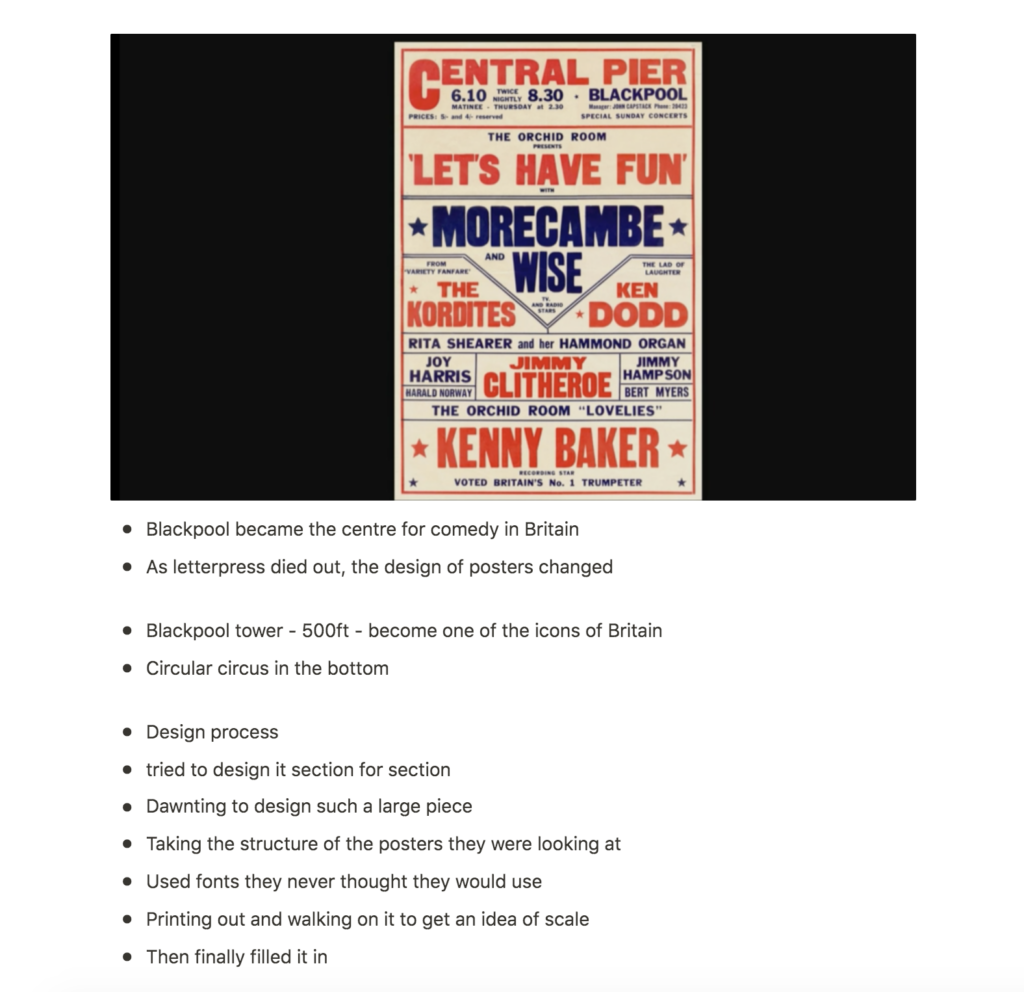


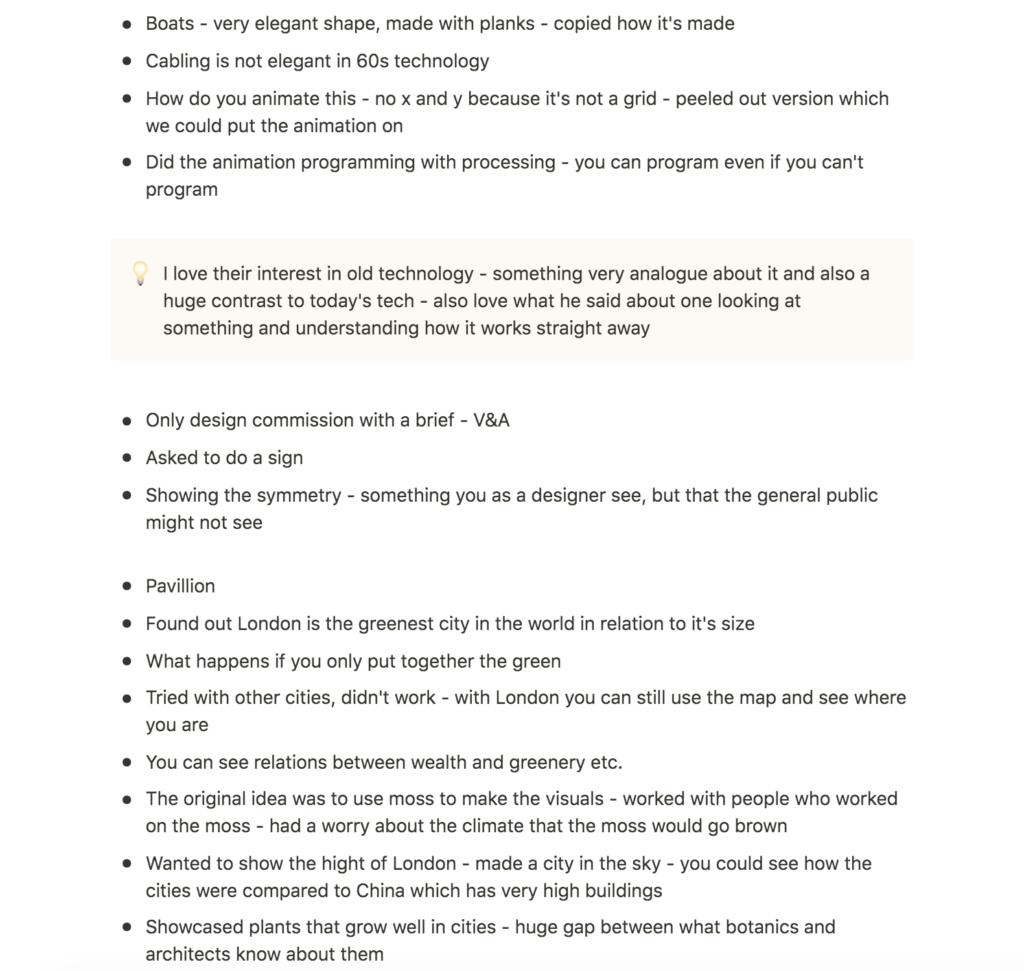
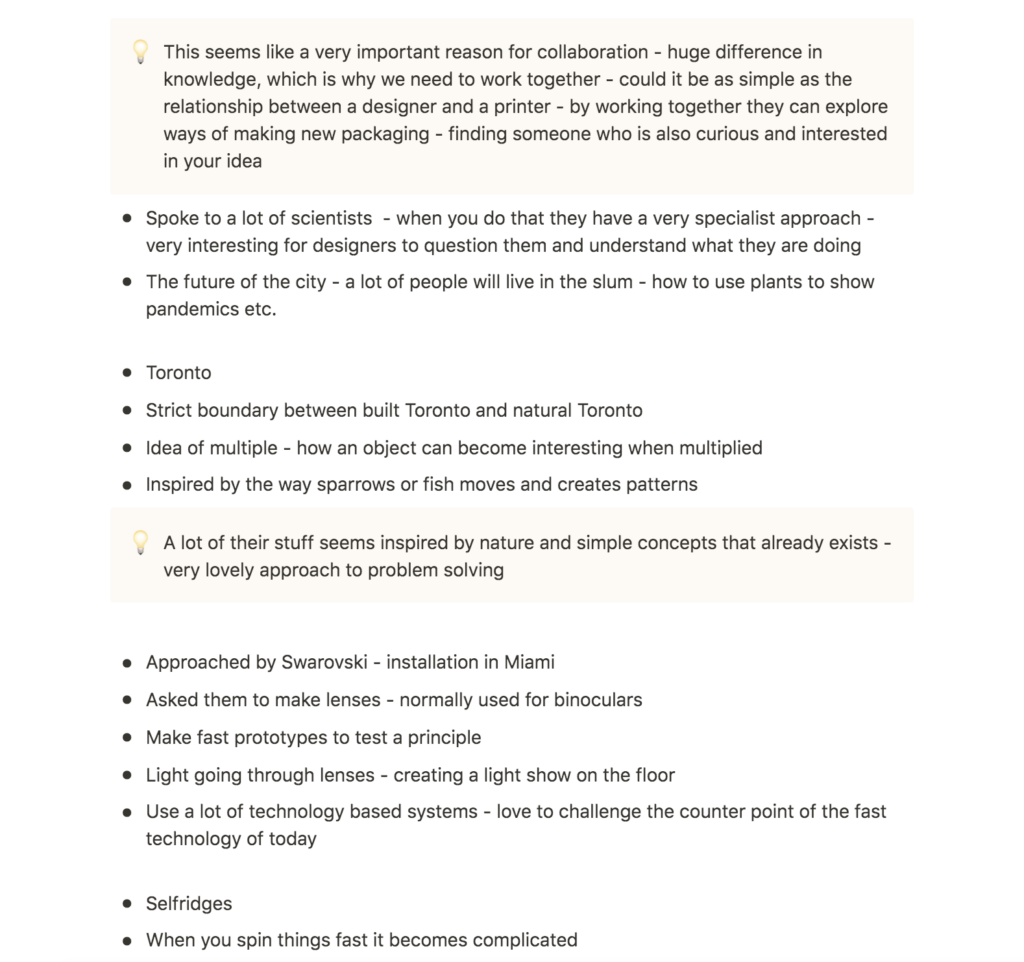
Resource reflections
Dinner for one
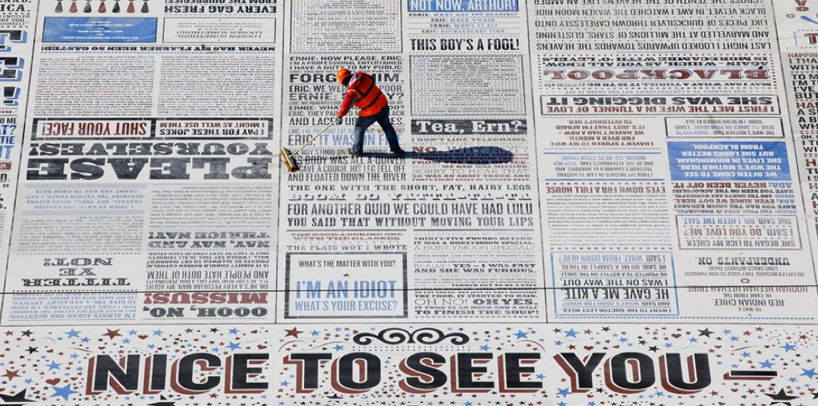
The Comedy Carpet was such a lovely project, both because of it’s process, and because of the light heartedness of it. In terms of collaboration I was very happy to find out that the concrete workers developed such an attachment to the project (Andy Altmann, 2012). I think as a designer you can often underestimate the value of your own ideas and projects. However, for people who build, do science, or is another type of expert, I can imagine it being very cool to be part of a project like this, where you get to make something truly unique. Altmann’s talk therefore inspired me to not be so scared about approaching experts for future projects.
The scale and vastness of the project also proved how collaboration can lead to amazing things that one wouldn’t be able to make on one’s own.
Lecture with Troika
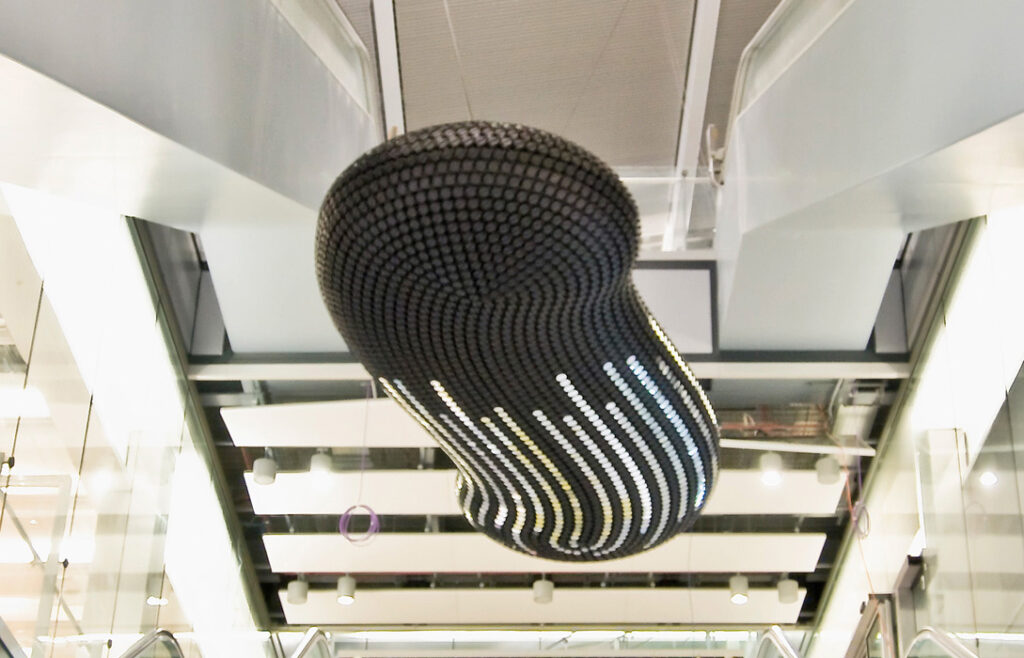
It was very interesting to hear about Troika’s case studies as all of the projects were so inventive and beautiful. I really liked their usage of old technology, particularly because of what Noel said about it being self explanatory (Sebastien Noel, 2012). Although it is technology based, it feels very analogue and tactile, and I think the way it works makes you want to look at it out of fascination of it’s essence, rather than it solely being cool and fancy.
In light of collaboration I also think what Noel said about there being a gap between the knowledge of botanics and architects, was important (Sebastien Noel, 2012). Since different experts have different knowledge, it makes great sense to work together. I think it can be easy to just sit and experiment in your own bubble as a designer, but Troika’s work shows that it’s not always the best option.
Further research
Zumtobel annual report
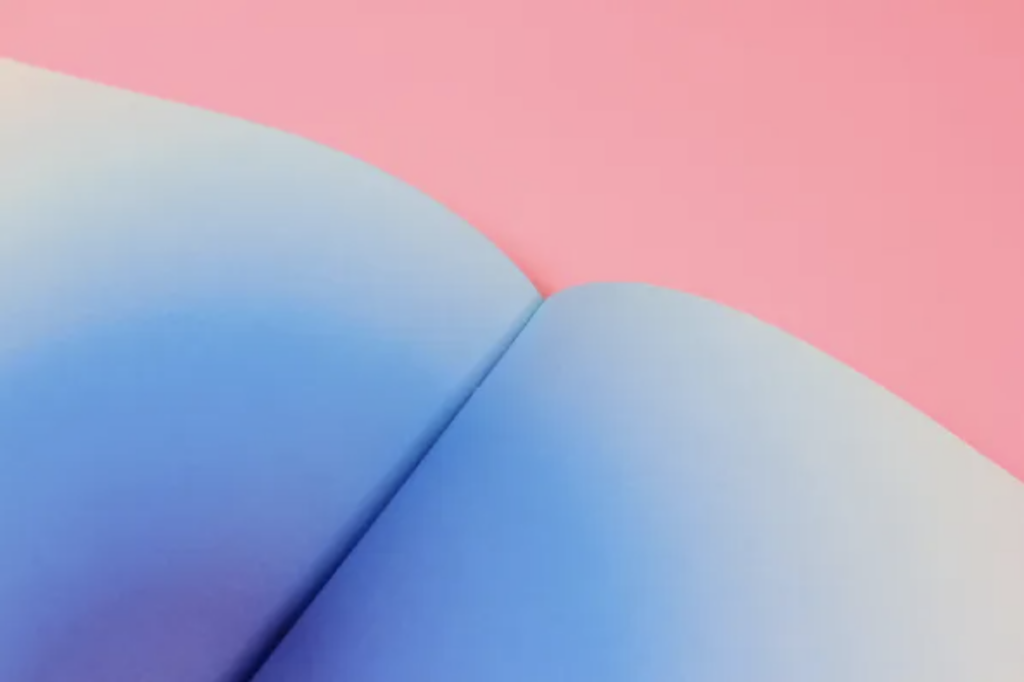
The Zumtobel annual report, mentioned in the lecture, is really beautiful and made me realise than an expert doesn’t necessarily need to be a scientist. It could also be a maker of e.g. prints, pottery, glasswork or other objects.
Fellesverkstedet
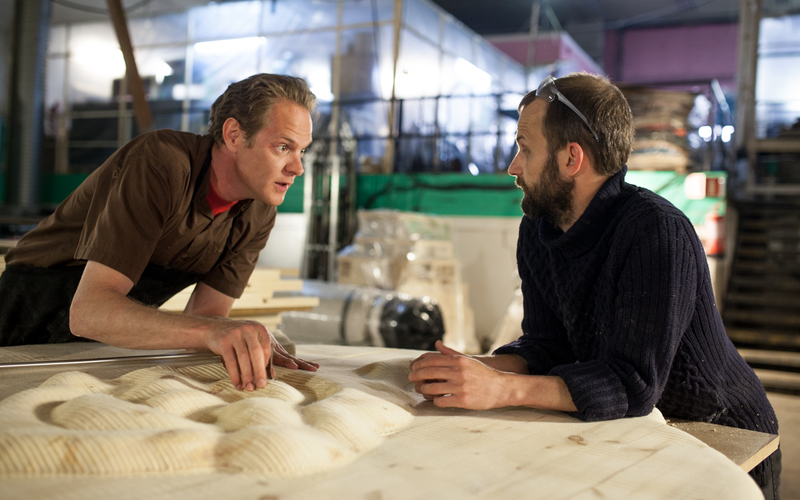
Depending on the project, Fellesverkstedet, who I listed in the geo tagging workshop for module one, could be an interesting collaborator (listed at fablabs). They provide workshops, as well as knowledge, and as I would like to work with tactility, this is something I might consider doing for the workshop challenge.
Workshop challenge
In order to identify a discipline, I started thinking about potential experts I already know. As suggested by Susanna in the lecture, using someone you know can help save time as the challenge is very brief.
As I was reflecting on friends and family’s occupations, I realised that I know people working within health care, education, economics, HR, government water systems, and probably lots of other things. From here, I got the idea of using my brother as an expert. He has just finished his MA in teaching and is interested in making the curriculum interesting and accessible to students. I therefore decided to look at how we can encourage greater engagement with galleries and museums amongst 14-18 year olds. My brother is also very different to me in being very pragmatic and not so used to working creatively, so I thought this could lead to an interesting discussion.
Structure
Inspired by one of Harriet’s posts on the ideas wall, I decided to look at design sprints for my communication strategy. This led me to look at lightning decision jams, a method which lets you brainstorm issues and solutions within a 25-40 minute session (Jonathan Courtney, 2017). Rather than starting a discussion straight away, this method lets participants brainstorm issues, as well as solutions for 7 minutes by themselves, which are later presented to the group (Jonathan Courtney, 2017). I personally think brainstorms out of thin air can be quite difficult, so I was eager to adopt the method in my interview.
The lightning decision jam is designed to solve issues without discussion (Jonathan Courtney, 2017), but since the workshop challenge actually asks us to discuss, I decided to adapt the structure slightly, by making room for discussion. In order to stick to the structure, and to make it easy for my expert to follow it, I made a very simple presentation with each step of the method, as well as room for notes on issues and solutions. This was in Norwegian, which is why I’ve left it out of this blog post.
Preparations & topic research
As suggested by Harriet on the ideas wall, I decided to research into my topic before the session. I also informed by brother about the topic and suggested that he’d have a quick think about ideas, so that he’s already be in the right mind set when doing our session.

The national public survey for Norwegian museums 2019-2020
In order to reveal some potential issues, I looked at Kulturrådet’s national public survey for Norwegian museums. The survey showed that 94% of the visitors goes to the museum with other people (Kulturrådet, 2020). It also showed that women with higher education had a good experience, whilst men with lower education had a poor experience (Kulturrådet, 2020). 15-24 year olds had lower attendance than other age groups (Kulturrådet, 2020). Most attendees had a Norwegian background, whilst those with minority backgrounds had poor attendance (Kulturrådet, 2020).
By making museums and galleries more valuable and accessible to everyone within the younger demographic, we might be able to reduce the differences between attendees’ backgrounds and education levels for future generations.

TikTok doubles number of young visitors to the Uffizi Gallery
In this blooloop article, Bea Mitchell discusses how Uffizi Gallery has increased attendance from the younger demographic through the usage of TikTok (Bea Mitchell, 2020). I think the usage of humour seems like a clever way of making the art world seem less pretentious and intimidating. Of course, the museum in itself would still have to appeal to the attendees, and preferably in a way that doesn’t make fun of the art works.
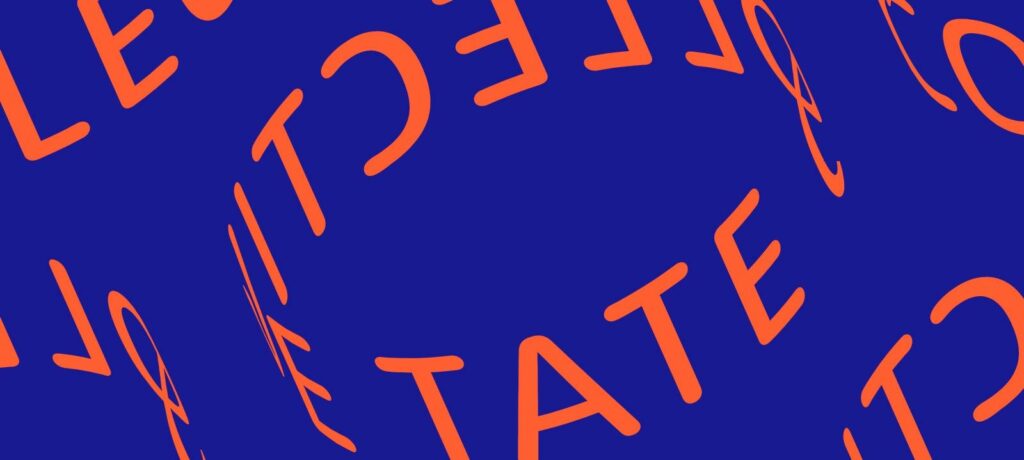
Tate collective
Although the target audience seems slightly older than mine, Tate’s collective offering seems like a good approach to attracting younger visitors. They offer cheaper tickets to exhibitions, discounts and special events. Their student resources also seem to offer materials on themes I’d imagine must be popular amongst the younger demographics, such as equality and getting into art school.
The concept of hosting special events for the younger demographic (perhaps without branding them as “youngster-friendly”) seems like a good way of conveying art towards a targeted audience. This way one might focus on topics younger people care about, bring in celebrities and perhaps communicate in a more laid back way (these details could be explored through interviews and testing, in order to find out how young people would prefer learning about art).
Interviewing and recording
I had my interview discussion through Zoom as my brother and I live in different cities. Inspired by Ben’s audio tips, I got him to record his own voice on his phone, and I on mine. This let me have more decent sound than a screen recording, and worked well.
As planned I followed the lightning decision jam method, although I let the presenting of ideas turn into a free discussion for the last 25 minutes. Through our first brainstorm, where we came up with potential issues, we voted on this as a focus issue for our discussion: Students and teachers are often unengaged when going to museums and galleries through school. They look at it as a day off and something they have to do because they need to go on field trips a certain amount of times each year. This led to us establishing a narrower focus question: How can we engage teachers and students during museum visits arranged by schools?
The focus question let us come up with lots of insight, but I did find that we struggled with coming up with specific ideas. At early stages of a project, this would have been very helpful, but at a later time, I think I would have had to steer the conversation more.
Designer vs. non-designer
I quickly found that Ole’s issues and insights revolved around teaching, which makes sense as he is a teacher. He had lots of insight which I hadn’t thought about, and were particularly informative when it came to the school system. In terms of solutions he was perhaps not as specific as me, but since this is more of a design skill, that makes sense.
I think this balance between providing insight and turning this insight into specific solutions is what seems so great about collaborating with a non-designer. If I had more time, I would have loved to do a second discussion round, where I focused on turning insight into more specific ideas in collaboration with Ole. Looking back, I also could have had a third brainstorm round during our first session, where we focused on turning one insight into more specific ideas of services, campaigns and so on.
Final ideas
Although they weren’t hugely specific, I made notes of what seemed to be the main ideas/points that resulted from our discussions:
- Changing attitudes: By introducing art to students at a younger age (from first grade), we will try to maintain a kinder garden like approach to art. In school, they shall make art and do research on art, which also teaches them how to read a text, image, film or other creative output. At 14-18 it might be too late to introduce this type of learning as they have learnt that art is something boring. Making art part of school demands decisions from Norway’s politicians, but we could make activist campaigns or create an art teaching service which schools could book.
- Focusing on introducing: Everyone will not be interested in art, but by introducing the students to museums and galleries, as well as what art is, we can spark an interest amongst those who have an interest without knowing about it. It’s about getting them to ask “can this be something for me?”. This could be done by a varied approach to presenting art, through the use of role play, workshops etc.
- Introductory exhibitions: Exhibitions targeted towards art beginners, which explains the essence of art, as well as the meaning behind each art work, to a larger extent than other exhibitions. These would be less ambiguous and therefore less intimidating.
- Smaller groups and more time: Students should be taught about the exhibitions in smaller groups, in order to create engagement. The teachers also needs allocated time to prepare, as they can’t take time away from e.g. history or math class to talk about upcoming field trips.
Final result
My final result this week is a 10 minute podcast summary of mine and Ole’s discussion on how we can engage teachers and students during museum visits arranged by schools. This focus question was established prior in our podcast recording, when we discussed issues 14-18 year olds might be having in relation to engaging with galleries and museums.
The summary consists of our discussion on possible solutions, but also more abstract insights on engaging the younger population.
In conclusion
This week has been slightly challenging as I’m not used to making podcasts or hosting workshops. However, getting to try out a workshop method on a person I know well was great as it was less scary than with a stranger. The workshop session showed me the value of discussing a topic with a non-designer, and how much insight talking to experts can provide within a single hour. In the future, I hope to make workshops a bigger part of my working life, but also of the discovery phase of my personal design practice.
During my discussion session, I quickly noticed that our conversation steered towards school and teaching, which makes sense as I interviewed a teacher. Yet, this observation was great as I hadn’t realised how much a brainstorm could focus on a particular topic due to this. Before this week, I thought about expert interviews as something to do once an idea was in place. However, my discussion session proved that these types of workshops can be great ways of providing general insight, as well as steering a project in a more focused direction before the idea has been established.
If I had more time this week, I would have liked to do a second round of interviewing, as that might have let me and Ole come up with more specific ideas. Looking back, I also would have liked to steer our conversation slightly, so that we could have focused more on specific ideas here as well. I am however happy with the amount of insight the podcast led to, and moving on I will take with me the method of interviewing experts as part of my research.
REFERENCES:
Andy Altmann (2012) Dinner for One? (TYPO Berlin 2012). Available at: https://www.typotalks.com/videos/altmann-typoberlin2012-2/ (Accessed: 5 July 2021).
Bea Mitchell (2020) ‘TikTok doubles number of young visitors to the Uffizi Gallery’, Blooloop, 28 September. Available at: https://blooloop.com/museum/news/uffizi-tiktok-young-visitors/ (Accessed: 7 July 2021).
Jonathan Courtney (2017) ‘Lightning Decision Jam — Solve Problems Without Discussion’, Medium, 29 March. Available at: https://medium.muz.li/a-super-simple-exercise-for-solving-almost-any-product-design-challenge-f9e6c0019d7d (Accessed: 7 July 2021).
Kulturrådet (2020) Den nasjonale publikumsundersøkelsen for norske museer 2019-2020. Kulturrådet. Available at: https://www.kulturradet.no/museumsutvikling/vis-artikkel/-/den-nasjonale-publikumsundersokelsen-for-norske-museer-2019-2020 (Accessed: 6 July 2021).
Sebastien Noel (2012) Lecture with Troika. (LYNfabrikken). Available at: https://vimeo.com/32655731 (Accessed: 5 July 2021).
Susanna Edwards and Louize Harries (2021) ‘Susanna Edwards & Louize Harries – Podcast’. Canvas Falmouth Flexible [online], 2 July.
LIST OF FIGURES:
Figure 1. Gordon YOUNG. 2011. Comedy carpet. Designboom [online]. Available at: https://www.designboom.com/art/gordon-young-the-comedy-carpet-blackpool/
Figure 2. TROIKA. 2008. Cloud. Troika [online]. Available at: http://troika.uk.com/project/cloud/
Figure 3. BRIGHTEN THE CORNERS. 2012. Zumtobel annual report. It’s Nice That [online]. Available at: https://www.itsnicethat.com/articles/brighten-the-corners-annual-report
Figure 4. Unknown maker. ca. 2012-2021. No title. [coloured photograph]. Fellesverkstedet [online]. Available at: https://www.fablabs.io/labs/fellesverkstedet [accessed 8 July 2021].
Figure 5. KULTURRÅDET. Ca. 2015-2021. Logo. Nopa [online]. Available at: https://nopa.no/statens-kunstnerstipend-2016-tildelt/kulturra%CC%8Adet/
Figure 6. Unknown maker. ca. 2020-2021. No title. [Tiktok meme]. Blooloop [online]. Available at: https://blooloop.com/museum/news/uffizi-tiktok-young-visitors/ [accessed 8 July 2021].
Figure 7. TATE. Ca. 2015-2021. Tate Collective. Tate [online]. Available at: https://www.tate.org.uk/tate-collective
Figure 8: Ingrid REIGSTAD. 2021. How can we engage teachers and students during museum visits arranged by schools?. Private collection: Ingrid Reigstad.
